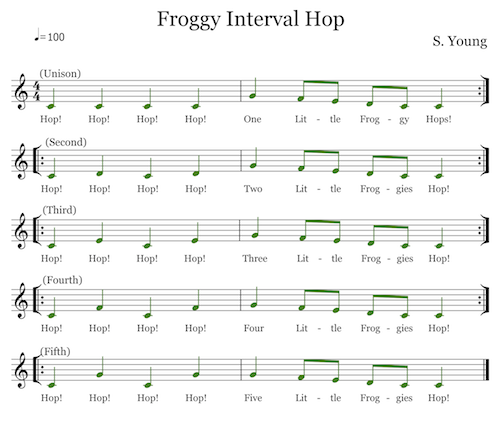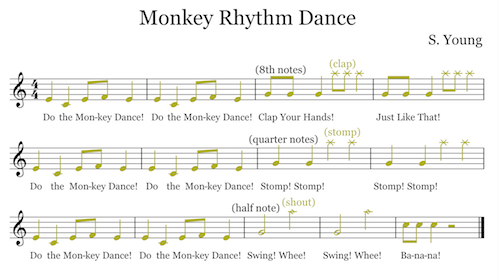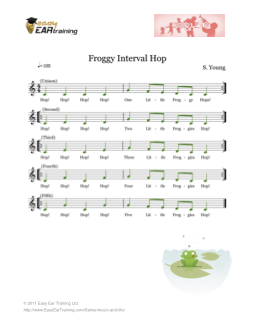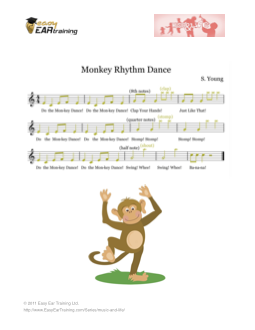In the last Music & Life article we looked at the role of songs in children’s musical development, and the many ways songs can be integrated into a child’s life. We’ve also looked at how lullabies help your child’s musical appreciation. Today we’re releasing two free songs which can help develop your child’s aural skills!
Music & Life author Sabrina Peña Young has composed these songs to help children learn about different intervals and rhythms.

Froggy Interval Hop
Here’s a fun little song which runs through major scale intervals from a second up to a fifth. With younger children you don’t need to worry about the interval names, but just singing the song will help them get used to different melodic leaps. Older children can use the song to help them learn the sound of each interval!

You can click on the score to view the interactive version at Noteflight.com.
Froggy Interval Game
You can also use this song to play a game in pairs: one person sings the first bar of a line (“Hop, Hop, Hop, Hop”) and the other has to identify the interval so they can sing the correct second bar (e.g. “Five Little Froggies Hop!”). Then swap over. This helps both players learn to sing the intervals clearly, and match the name of the interval with its sound.

Monkey Rhythm Dance
This song can help introduce children to half notes, quarter notes and eighth notes, and lets them practice singing and making noises in time with the music. As we learned in “Singing and Childhood”, adding actions to songs can help children enjoy music and remember the songs. Monkey Rhythm Dance uses different actions for each rhythm to make each more distinctive – and fun!

You can click on the score to view the interactive version.
Monkey Rhythm Games
There are lots of games you could try with this song. For example, in pairs, one person can sing the first two bars (“Do the Monkey Dance!”) while doing one of the three actions (clap, stomp, or mime shouting), and the other person has to sing back the other two bars to match (e.g. “Clap Your Hands! Just Like That!”). This is a good way to drill the three rhythms.
Another idea is to sing together, but do a simple call/response with the second half of each line. For example, one person (or group) sings “Clap Your Hands!” and the other has to clap their hands in the same rhythm in response. Then likewise for “Just Like That!”. This is good practice for call-and-response pattern, which is common in ensemble playing.
Ways to use these songs
You can use these songs with your own child, learning the song together. Depending on their age you can explain the intervals or rhythms being used, or simply enjoy the music. Try the songs in pairs or groups to practice the musical elements or play games trying to catch each other out. You could also use them in a classroom setting to teach the theory by example – or just to have fun at the end of class!
However you use them, we hope you’ll enjoy these songs! Feel free to pass them on to friends, other parents and musicians. If you have any comments or stories to share, please leave a note in the comments below!











These are fabulous! I look forward to using them with my students!
Hello Natalie,
I am so glad that you enjoy the songs! I had a great time writing them. Let us know how the kids like Monkey Rhythm Dance and Froggy Interval Hop!
:-)
Sabrina Pena Young
How comes that you you associate monkeys with rhythmic dance?
Hello Mostafa,
I was inspired by the fun book "Five Little Monkeys" which almost every little kid (including my own) just loves to read! Kids love animals, especially ones that move a lot like frogs, bunnies, and silly monkeys. I think having to read this book a dozen times a day to my little girl has almost driven me bananas!
:-)
Sabrina Peña Young